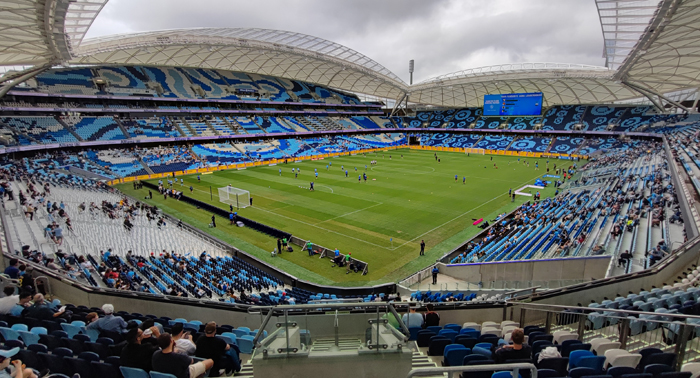In Australia and New Zealand, various major projects are currently in the planning phase or have already been started. With a view to the 2032 Olympic Games, the city of Brisbane is facing promising construction projects.
New Zealand is, just like Australia, facing billion-euro-investments in stadium infrastructure. In Auckland, for example, the debate is currently raging about whether to go ahead with a comprehensive conversion and expansion of Eden Park (under the project name Eden Park 2.0) or the construction of a new waterfront stadium in Waitematā Harbour with a capacity of up to 70,000 people. In view of the scope and dimensions of both projects (in connection with the stadium construction in Christchurch), the New Zealand Herald already ran the headline of imminent “stadium wars”.
With Eden Park having just been upgraded for the Women’s World Cup, the national stadium could be expanded to 60,000 seats through the construction of two new grandstands, plus a retractable roof so that events could be held year-round regardless of the weather. The project also includes the option of an adaptive pitch, which can be adjusted in shape depending on the sport. Finally, the construction of a pedestrian bridge over Sandringham Road is also planned. The costs of a conversion have not yet been determined, but it is assumed that several hundred million euros would be due.
As a counterpart, a design by architect Phil O’Reilly was already published in 2017 that envisages the construction of a new stadium along Bledisloe Wharf in Auckland Harbour. The plans, which have since been revised, envisage building a stadium costing around 1 billion euros, with the interior to be recessed so far into the seabed that it will subsequently lie a full 28m below sea level. The costs are to be refinanced through the construction of flats as well as commercial and public buildings on the 90,000-square-metre Eden Park site, thus allegedly not burdening the taxpayer. If the project goes ahead as planned, the Waterfront Stadium would be a unique selling point for the city of Auckland.
Another major project in the country is already in the implementation phase in Christchurch. Based on a design by the Kōtui Consortium, a new multifunctional stadium, Te Kaha, is being built for over 600 million euros. The city hopes the stadium will ”add to the vitality of the city centre, boost further development, make Christchurch a sporting and cultural capital once again and boost the city’s economy by attracting visitors from across New Zealand and the world.” The target capacity is 30,000 seats for sporting events and 36,000 seats for major music events, with a completion date in 2026.

The new Allianz Stadium in Moore Park, a suburb of Sydney, officially opened in August 2022.
Image: Colin Willemin
In Australia, the focus is already on the 2032 Summer Olympic and Paralympic Games in Brisbane. The coastal city in the east of the country won the bid to host the Games in 2021 and will therefore receive some new highlights in terms of its sports infrastructure. The Games are scheduled to take place from 23 July until 8 August 2032 in three different areas, with the city of Brisbane as the focal point with 21 venues. Another six venues will be located on the Gold Coast, 65 km away, and competitions will be held in three venues on the Sunshine Coast. (STADIAWORLD, 04.09.2023)
The full article with all the data can be found in the new SPORTS VENUES 2023/24. Click here to go directly to the story. Also in the yearbook: the construction report for various other countries and continents, portraits of internationally relevant stadiums and arenas, the Tech Report on the most important trends and topics in the industry as well as a variety of interviews and much more.